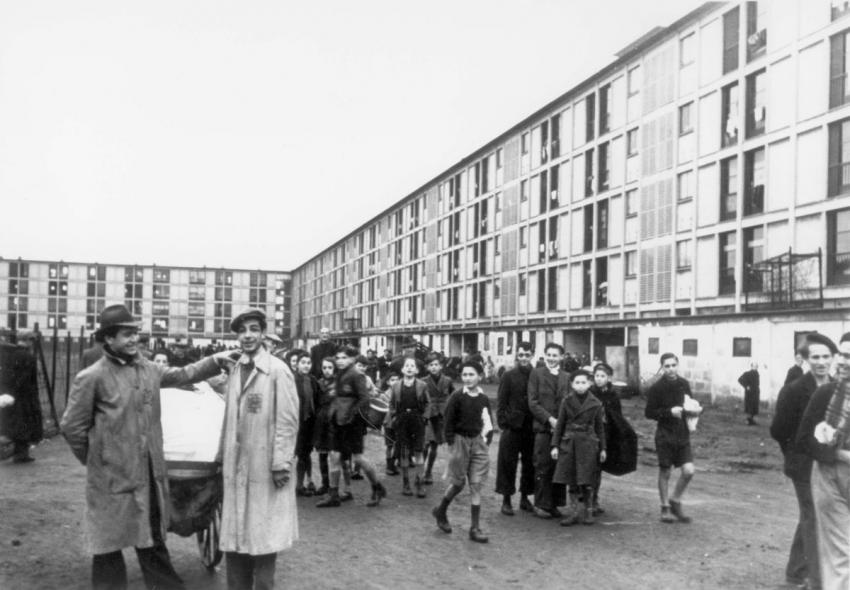Bread distribution by the Nazis at the Drancy detention camp near Paris, France. Some 70,000 Jews were incarcerated in this camp over the three years of its operation, from summer 1941 to summer 1944. Almost all of them were deported to the extermination camps in eastern Europe.
In August 1941, a detention camp was established in the city of Drancy, northeast of Paris. The inmates were housed in a long, cement, four-storey building which was used by the Paris area Gendarmerie before the war. At its height, the camp held 4,500 prisoners. They were guarded by French policemen.
The food supplies at the camp were very meager. A daily ration consisted of 600-800 calories. From August 1942, the prisoners took over the running of the camp from the French, and by November, conditions improved slightly thanks to assistance from Jewish organizations and the Red Cross, and the food parcels sent by family members. The photograph documents the distribution of bread to Drancy inmates in December 1942. On the back of the photograph is the German inscription: "Distributing bread to the Jews".
The Germans took over the running of the camp in July 1943, headed by new commander Alois Brunner, resulting in a deterioration of living conditions for the inmates. The food rations were reduced, and deportations to extermination camps in the east gathered momentum.
Despite the difficult living conditions, Jews in the camp maintained a cultural and religious existence. They arranged concerts and literary evenings, and the prisoners read books that had been smuggled into the camp. A school was established, and even after its official closure in January 1943, it continued to operate clandestinely. Hundreds of Jews participated in Sabbath prayers and religious ceremonies, and marked Rosh Hashanah (the Jewish New Year) and Yom Kippur (the Day of Atonement) in the synagogue that had been set up in September 1941. In June 1942, the Germans issued an order forbidding Jewish ceremonies, but the High Holidays were still observed in the fall of 1943.
Drancy prisoners included French poet Max Jacob, who perished in the camp in 1944; Pierre Masse, member of Georges Clemenceau's government (Masse was deported to Auschwitz in September 1942 and murdered); Rene Blum, brother of 1930s French Prime Minister Leon Blum; author Tristan Bernard; Jankiel Handelsman and Jozef Dorebus, who were deported to Auschwitz and were two of the leaders of the Sonderkommando uprising there in October 1944.
41 escape attempts were made by prisoners. In September 1943, 70 prisoners started to dig an escape tunnel four meters underground. The digging work was discovered in November 1943 and many prisoners were executed, including the camp's resistance leader, Robert Blum.
From June 1942 to July 1944, approximately 65,000 Jews were deported to extermination camps in eastern Europe, on 64 transports. More than 20,000 deportees had French citizenship, some 15,000 were Polish Jews, and some 6,000 were from Germany. Most of the deportees were sent to Auschwitz. Three transports, approximately 3,300 Jews, were deported to Sobibor.
In early August 1944, Allied troops reached Paris. On the night of 15 August, the Germans destroyed all the camp documentation, and abandoned Drancy the next day, leaving about 1,500 prisoners. On 17 August, the camp was liberated by the Allied Forces. The last transport from Drancy had left less than three weeks earlier, on 31 July 1944. Amongst the deportees were 79 schoolchildren and 12 teachers from the Lucien Hirsch school in northern Paris.They had been arrested on 24 July 1944. A witness to the deportation, a child at the time, wrote in 1987:
I saw the children climbing aboard two German trucks. To me it looked like the children were going on an outing, despite the fact that their teacher was crying… A soldier helped the children to climb up.
On 21 July 1944, in the middle of the night, 18-year-old Yvette Levy was arrested with another 30 girls at the orthodox Jewish boarding school they attended in Paris. Policemen in uniform forced the pyjama-clad girls onto a truck that took them to Drancy. At the camp, Yvette took care of the younger children, sang to them and tried to boost their morale. They slept on straw in one room in deplorably unsanitary conditions, and were deported in cattle cars, 60 to a car.
18-year-old Denise Holstein, from a children's home west of Paris, was in a cattle car holding 48 children and 12 adults:
At night, when we tried to put the children down to sleep and it was pitch black, they started to cry and no one managed to sleep for even a minute. The children were hot and thirsty; there was no air at all. But we kept our spirits up. We had to because we were in charge of the children, and crying was not an option.
Over 95% of the deportees from Drancy were murdered in the Holocaust.
Yad Vashem Photo Archive 5494/29

